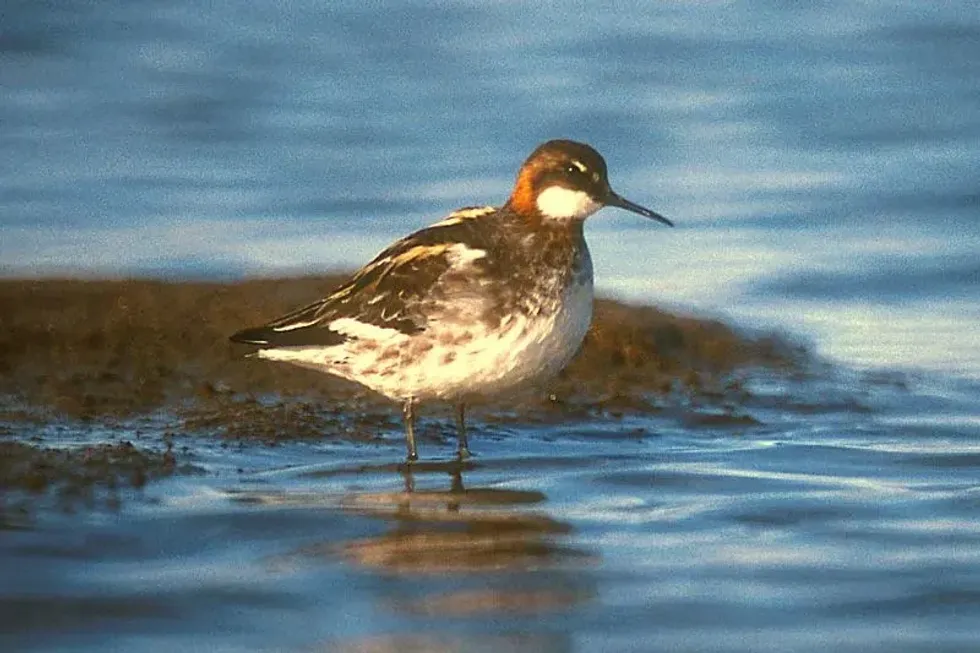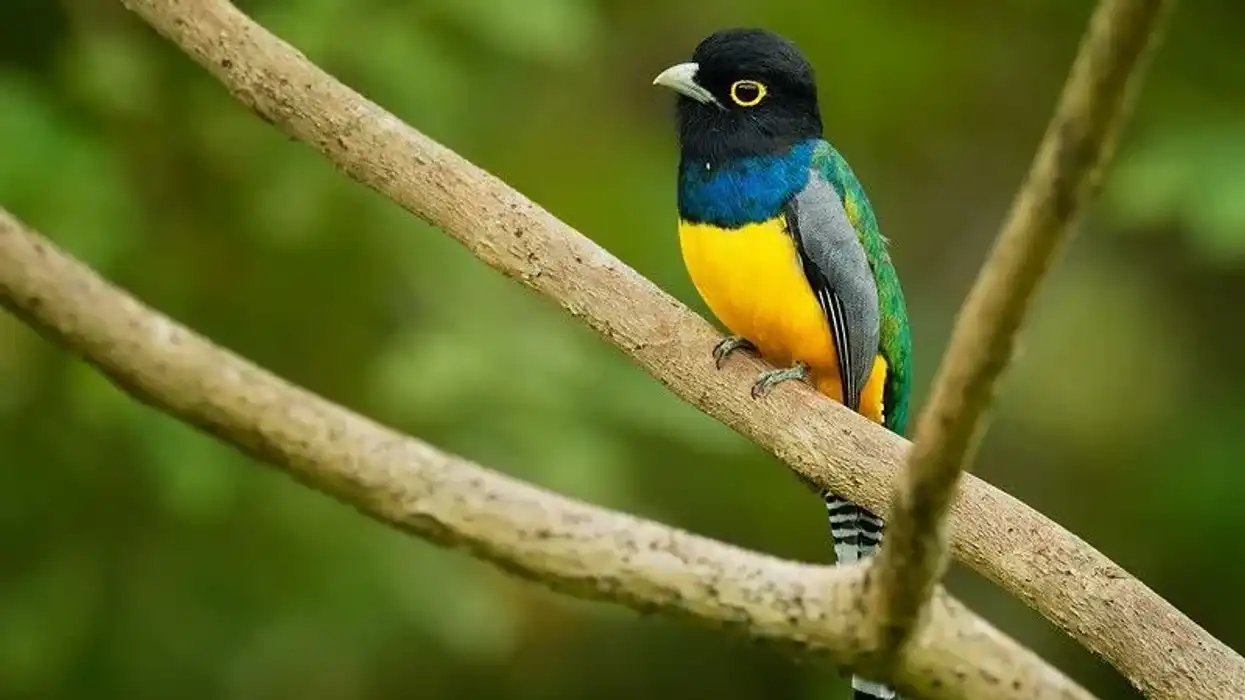The Red-Necked Phalarope, Phalaropus lobatus as it is scientifically known, belongs to the Scolopacidae family. Phalaropes come from the French word phalarope and the scientific name Phalaropus is derived from the ancient greek phalaris meaning coot and pous meaning foot and Lobatus is Latin for lobed.
It was initially known as Northern Phalarope. It is found in the Arctic tundra, around Britain, and in the non-breeding season, they can be found in parts of South America, in the Arabian sea.
They can also be found in parts of Indonesia. Reproduction in this species is known to be monogamous and polygamous sometimes and takes place on the surface.
Females are known to arrive before the male on the breeding grounds and after copulation, a nest is built by both parents using leaves and stems near the water and the eggs are laid, and the female leave after that, and only the males incubate the eggs. The female of the species is brightly colored than the males.
The breeding plumage of the females has a gray head, neck, and side parts of the neck, and the stomach part is white in color.
The collar is chestnut-colored and it has a white throat. The male adult is just dull in color.
The young ones have a similar appearance with brown parts and white underparts and a slightly washed color on the breast part. This bird has lobed toes for swimming.
If you want to learn more such fascinating facts about this species, keep reading. If you are interested, read about the Nicobar pigeon and golden pheasant too.
Red-Necked Phalarope Interesting Facts
What type of animal is a Red-necked Phalarope?
Red-Necked Phalaropes are birds.
What class of animal does a Red-necked Phalarope belong to?
These phalaropes belong to the class of Aves of birds.
How many Red-necked Phalaropes are there in the world?
The global breeding estimated population is around 4.1 million.
Where does a Red-necked Phalarope live?
It can be found in coastal regions of the Arctic tundra or ocean, around Britain, and in the non-breeding or the winter season, they can be found in parts of South America, in the Arabian sea. They can also be found in parts of Indonesia.
What is a Red-necked Phalaropes habitat?
These birds are known to inhabit forest tundra or areas near lakes, ponds, or an open ocean and wetlands along the marshes. These areas consist of moss, grasses, and sedges.
They also have been observed in coastal moorlands. It has also been recorded that during migration these birds are found near saline lakes, and they spend their winters in upwelling areas of the sea and ocean slicks.
Who do Red-necked Phalaropes live with?
These birds generally live alone or are solitary during the summer season and can be seen in groups or flocks during migration to breeding grounds and in winters.
How long does a Red-necked Phalarope live?
This bird is known to live for about five years in the wild.
How do they reproduce?
These species arrive on the breeding grounds, near the ocean surface around mid-June, and females are known to arrive before males. In general, these birds have a monogamous system but when the males are in large numbers or in excess, the females mate with a different mate or male on the surface.
After copulation, both of them start making nests and build nests. The nest is made with leaves and stems and is near the water.
Three to four eggs are laid; they are singly brooded if the system was monogamous and double-brooded if it was polygamous. The eggs are incubated by the males. The red-necked Phalarope incubation period lasts for about 20 days.
Females leave as soon as the chick hatches and males stay with them for more time. The chicks develop or fledge at around 18-21 days.
What is their conservation status?
The conservation status of these birds is Least Concern.
Red-Necked Phalarope Fun Facts
What do Red-necked Phalaropes look like?
The females of this species are more brightly colored than males The breeding plumage is darker than the winter plumage. The plumage of the females is a gray head, neck, and side parts of the neck, and the stomach part is white in color.
The collar is chestnut-colored and it has a white throat. The wings are cream or tan colored and the eye has a small white band above it.
The males have duller color plumage and are like brown in color.
The winter or the non-mating plumage of this bird is dull and has dull gray upper parts and the head is white with a black patch around the eye. The young ones have a similar appearance with brown parts and white underparts and a slightly washed color on the breast part.
How cute are they?
These birds are not considered cute.
How do they communicate?
Not much information is available about the communication of these birds but it is believed that these birds use visual, tactile, and acoustic cues and produce several loud calls.
How big is a Red-necked Phalarope?
The bird is considered to be Robin-sized and is known to be larger than a Least Sandpiper and is slightly smaller than a Red Phalarope. These birds are up to 7.1 in (180 mm) in length.
How fast can a Red-necked Phalarope move?
The exact speed of these birds is unknown but are known to move fast. The wingspan of these birds is 12-13 in (310-340 mm).
How much does a Red-necked Phalarope weigh?
The weight of these birds ranges from 0.04-0.105 lb (0.02-0.048 kg).
What are their male and female names of the species?
There are no specific names for the males and females of the species.
What would you call a baby Red-necked Phalarope?
A baby of this bird is called a chick or young.
What do they eat?
The food of this bird consists of insect larvae during the breeding season in freshwater environments. The food also includes flies, beetles, worms, snails, and some seeds. They tend to feed on zooplankton, crustaceans, tiny fish, and jellyfish in the winter or the non-mating season at the sea. They are known to forage by walking, wading, and swimming.
Are they poisonous?
These birds are not poisonous and are not considered harmful.
Would they make a good pet?
Not much information is available about these birds as pets but it is believed that these birds do not make good pets as they are wild and migratory.
Did you know...
Female phalaropes in general, are known to fight over males and take little or no part in taking care of the young.
The oldest record of the Red-necked Phalarope, Phalaropus lobatus as it is scientifically known, is known to be a male which was five years old at the time of capture and was released at a banding station in Alaska.
This bird was initially called a Northern Phalarope.
This bird is the smallest in the genus and has the shortest bill.
A group of phalaropes is called dopping, swirl, twirl, whirl, and a whirligig of phalaropes.
This species was first described by Carl Linnaeus in 1958 and it was given the binomial name Tringa Lobata and was also known as the Coot-footed Tringa in 1750.
Red Phalarope vs Red-necked Phalarope
The red Phalarope description includes a white mask, rufous-brownish throat, and underparts.
The bill of this species is known to be heavy.
The juvenile or the young and the winter plumage of the Red-Necked Phalarope can be often confused with the Red Phalarope while the adult ones are quite distinguishable as they tend to have stripe-like patterns on the backs and a black patch around the eye, are somewhat gray in color, and the bill of this bird is thin or sleek and light.
The breeding plumage is darker as compared to winter plumage.
Are they predators?
These birds are known to prey on insects and some other crustaceans and are known to control the population of mosquito larvae as mosquitos are considered to be serious pests around certain parts of the world.
Here at Kidadl, we have carefully created lots of interesting family-friendly animal facts for everyone to discover! Learn more about some other birds including the shoebill and frigatebird.
You can even occupy yourself at home by drawing one on our Red-Necked Phalarope coloring pages.










